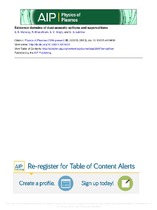Existence domains of dust-acoustic solitons and supersolitons
Existence domains of dust-acoustic solitons and supersolitons
| dc.contributor.author | Maharaj, S.K. | |
| dc.contributor.author | Bharuthram, Ramashwar | |
| dc.contributor.author | Singh, S. V. | |
| dc.contributor.author | Lakhina, G. S. | |
| dc.date.accessioned | 2017-02-20T10:33:20Z | |
| dc.date.available | 2017-02-20T10:33:20Z | |
| dc.date.issued | 2013 | |
| dc.identifier.citation | Maharaj, S. K. et al. (2013). Existence domains of dust-acoustic solitons and supersolitons. Physics of Plasmas, 20: 083705 | en_US |
| dc.identifier.citation | Maharaj, S. K. et al. (2013). Existence domains of dust-acoustic solitons and supersolitons. Physics of Plasmas, 20: 083705 | |
| dc.identifier.issn | 1070-664x | |
| dc.identifier.uri | http://hdl.handle.net/10566/2556 | |
| dc.identifier.uri | http://dx.doi.org/10.1063/1.4818439 | |
| dc.description.abstract | Using the Sagdeev potential method, the existence of large amplitude dust-acoustic solitons and supersolitons is investigated in a plasma comprising cold negative dust, adiabatic positive dust, Boltzmann electrons, and non-thermal ions. This model supports the existence of positive potential supersolitons in a certain region in parameter space in addition to regular solitons having negative and positive potentials. The lower Mach number limit for supersolitons coincides with the occurrence of double layers whereas the upper limit is imposed by the constraint that the adiabatic positive dust number density must remain real valued. The upper Mach number limits for negative potential (positive potential) solitons coincide with limiting values of the negative (positive) potential for which the negative (positive) dust number density is real valued. Alternatively, the existence of positive potential solitons can terminate when positive potential double layers occur. | en_US |
| dc.description.abstract | Using the Sagdeev potential method, the existence of large amplitude dust-acoustic solitons and supersolitons is investigated in a plasma comprising cold negative dust, adiabatic positive dust, Boltzmann electrons, and non-thermal ions. This model supports the existence of positive potential supersolitons in a certain region in parameter space in addition to regular solitons having negative and positive potentials. The lower Mach number limit for supersolitons coincides with the occurrence of double layers whereas the upper limit is imposed by the constraint that the adiabatic positive dust number density must remain real valued. The upper Mach number limits for negative potential (positive potential) solitons coincide with limiting values of the negative (positive) potential for which the negative (positive) dust number density is real valued. Alternatively, the existence of positive potential solitons can terminate when positive potential double layers occur. | |
| dc.language | en_US | |
| dc.language.iso | en_US | en_US |
| dc.publisher | AIP Publishing | en_US |
| dc.publisher | AIP Publishing | |
| dc.rights | This article was distributed under the terms of the Creative Commons CC BY-NC-ND 4.0 License. This is the final publisher's version found online at http://dx.doi.org/10.1063/1.4818439 | |
| dc.subject | Dust-acoustic solitons | en_US |
| dc.subject | supersolitons | en_US |
| dc.subject | Sagdeev potential method | en_US |
| dc.subject | Dust-acoustic solitons | |
| dc.subject | supersolitons | |
| dc.subject | Sagdeev potential method | |
| dc.title | Existence domains of dust-acoustic solitons and supersolitons | en_US |
| dc.title | Existence domains of dust-acoustic solitons and supersolitons | |
| dc.type | Article | en_US |
| dc.type | Article | |
| dc.privacy.showsubmitter | FALSE | |
| dc.status.ispeerreviewed | TRUE | |
| dc.description.accreditation | ISI |

